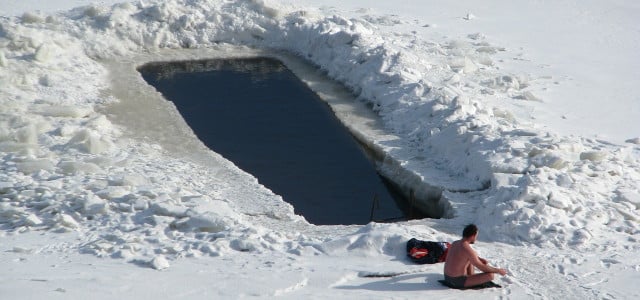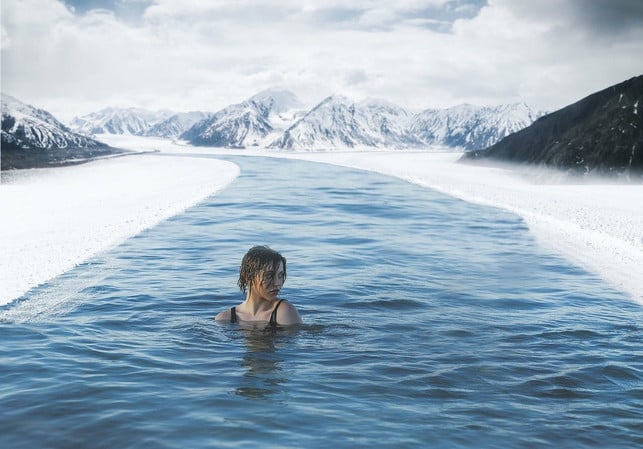
In the water in freezing temperatures: ice bathing is becoming increasingly popular. You can find out here how you can ice swim safely and whether it is good for your health.
When the first snowflakes fall and the thermometer shows low temperatures, the swimming season is over – for most people anyway. Because fans of ice bathing wait longingly until it gets frosty and they can climb into the icy water.
In this article we explain what ice bathing is, how it affects your body and what you should pay attention to.
What is ice bathing?

(Photo: CC0 / Pixabay / fintuq)
When ice bathing, you immerse your body up to your head in water that has a temperature of almost zero degrees for a few seconds or minutes. Many cold fans hope that the experience will give them a strong immune system and a healthy circulation.
Ice or winter bathing has a tradition in Russia, among other places. But the trend has also arrived in Germany: According to the Süddeutsche Zeitung, there were already around 3,000 ice swimmers nationwide in 2015 and more and more people are meeting at lakes and bodies of water for New Year’s swimming.
The “Wim Hof method” is popular among advanced winter swimmers. The bathers breathe in and out deeply, which is intended to alleviate the cold shock. Then they hold their breath for a short time. Wim Hof – the inventor of the method – is a Dutch extreme athlete who regularly exposes himself to bitter cold and extreme situations. He has already run a half marathon barefoot in the Arctic Circle and climbed Mount Kilimanjaro – wearing only a pair of swimming trunks.
Is ice bathing healthy?

(Photo: CC0 / Pixabay / SawanJuggessur)
It is well known that taking a sauna properly strengthens the immune system. The body is exposed to extreme heat. Can a reverse stimulus, i.e. cooling the body, have the same effect?
“Scientifically there are no reliable findings on positive health effects,” says sports medicine specialist Prof. Martin Busse to the German Press Agency (dpa), referring to ice bathing. But: There is a lot of evidence of beneficial effects – specifically that it could reduce the risk of respiratory infections and cardiovascular diseases and lead to improved stress tolerance.
“Of course, all of this only applies to regular cold water bathing, not just one-off bathing on any special occasion,” explains Busse, who heads the sports medicine university outpatient clinic in Leipzig.
There is also a study that shows that winter bathing fun trains the blood vessels. The fact is that when you immerse yourself, the vessels in the skin constrict and more blood flows into the widened, internal bloodstream. With this mechanism, the organism ensures that the core temperature is maintained. The increased blood flow (hyperemia) has a stabilizing effect on blood pressure and the cardiovascular system.
The study also describes that ice bathing or ice swimming appears to have positive effects on insulin levels and can also influence other hormones. In another study, rheumatism, fibromyalgia and asthma also show health improvements through winter bathing.
Ice bathing releases adrenaline and endorphins. They provide a special “kick” and a euphoric feeling after the bath. This effect could benefit mental health in the long term. If you’re not one for extremes: Studies suggest that a regular cold shower also helps against depressive moods because the body releases beta-endorphin and norepinephrine.
This is how you properly prepare for ice bathing
It’s best to start the first step towards an ice bath in the bathroom at home – by taking a cold shower. “In the first week it can only be short intervals, which you then gradually increase,” says Constantin Falcoianu from the online portal eisbaden.de, who has been going ice bathing regularly for more than ten years. Thanks to cold showers, the body can gradually get used to the cold. Wim Hof also recommends cold or alternating showers in the morning to start with.
This can mean:
- In a week you take a cold shower for 15 seconds at a time,
- in the following one doubles to 30 seconds.
- Then you increase it to 45 seconds and
- finally to 60 seconds.
If you follow this plan, you should be ready for your first ice bath after about a month.
By the way: the rain barrel or the hot tub in the garden are also an option. Getting started with ice bathing is often easier there because you don’t have to leave your usual surroundings.
The dangers of ice bathing
Ice bathing can be life-threatening for inexperienced or sick people. It is advisable to visit a cardiologist before taking a cold bath to rule out possible heart defects. Anyone who has cardiovascular problems should avoid ice swimming, as the cold shock can lead to cardiac arrhythmias or cardiac arrest. Because of the sudden cold, the heart rate drops but the blood pressure rises. “These sometimes opposite reactions increase the heart risk,” explains doctor Busse.
There is also a risk of hypothermia when taking ice baths. Even a body temperature of 30 degrees Celsius is life-threatening; if it falls below 26 degrees, there is no longer any chance of survival. Martin Busse explains how quickly this can happen when ice bathing: You can recognize the onset of hypothermia “by the start of cold shivering, which always indicates a drop in core body temperature.” If it occurs, you should definitely leave the water. “If in doubt, 30 seconds can be a lot.”
Cold shock, hypothermia or a rapidly declining swimming performance are particularly dangerous for untrained ice swimmers and can lead to death.
You should pay attention to this when ice bathing

(Photo: CC0 / Pixabay / 12019)
Falcoianu recommends shallow waters. “This makes it easy to get in and allows you to react quickly in an emergency situation and get out of the water.” Steep banks, on the other hand, are dangerous. “The basic rule is: never alone, never without possible contact with the ground, only swim directly on the shoreline and always be available for helpers,” summarizes Martin Busse.
Also, you should never go swimming alone. If the worst comes to the worst, help is essential. Since holes are often made in the ice cover of a lake, especially when ice bathing, experienced supervision is highly recommended here too. She can help or get help if people suddenly disappear under the ice.
As with classic swimming in summer, the same rule applies to ice bathing: do not go into the water on a full stomach. “Digestion is interrupted when bathing in ice, which means that the food in the stomach is not digested for a longer time,” says Falcoianu.
And then?
Falcoianu considers warming up to be one of the most important moments in ice bathing. “After the ice bath, the so-called “after drop” sets in,” he explains. “The blood vessels open again and the cold blood from the periphery mixes with the warm blood from inside the body.” This initially creates a clear feeling of cold.
When warming up, you should give your body enough time. “If you warm up too quickly, the constriction of the blood vessels suddenly loosens and the cold blood from the body shell flows back into the body core too quickly. This can trigger life-threatening cardiac arrhythmias,” warns Falcoianu.
The right way is to go into a room with a pleasant temperature and shiver warmly. “You can wrap yourself up in a blanket and maybe also take a heating pad or a hot water bottle.” And then: just enjoy it – and be proud that you have overcome yourself.
In summary, you should pay attention to the following before, during and after ice swimming:
- Only when visibility is clear and the weather is calm
- In shallow waters, with bottom underfoot
- Jog for about 15 minutes before ice bathing to warm yourself up (recommendation from the information website www.eisschwimmer.de)
- We lose a lot of heat through our heads – so only immerse yourself up to your chest and it’s best to put on a hat.
- Bathe only briefly: The icy bath should not last longer than five minutes. Listen to your body and, if in doubt, get out of the water earlier!
- Then quickly put on warm clothes, drink warm tea if possible and go to a warm room.
- Important: Heating yourself up too quickly can also be dangerous.
- Don’t go into the water with a completely full or completely empty stomach.
- Only with accompaniment, never alone!
Read more on Techzle\.com:
- Cold sauna: effect and functionality
- How cold balm protects you in winter – and 4 recommended brands
- 7 common winter mistakes – and how to avoid them
English version available: 9 Health Benefits of Ice Baths That Will Make You Brave the Cold
** marked with ** or orange underlined Links to sources of supply are partly partner links: If you buy here, you are actively supporting Techzle\.com, because we then receive a small part of the sales proceeds. More info.